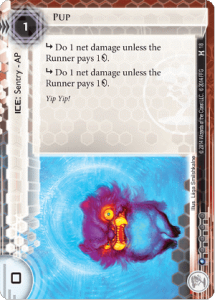Hello, and welcome to Deckspace, where we discuss offbeat Netrunner deck concepts! I can’t promise that all the decks you see in this column will be good, but I can promise you they will be interesting.
Coming from a Magic: The Gathering background, my first approach to Netrunner deckbuilding was this:
“Well, if Runner decks dedicate most of their cards to breaking ICE, I can blank most of their cards by not running any ICE!”
Sadly, this was back in the days of the Spin Cycle; Honor and Profit hadn’t come out yet, and so that deck fell flat on its face. But now that we have cards like House of Knives, Cerebral Cast and Psychic Field, the deck is a real contender.
The Decklist
Jinteki Personal Evolution
15 influence spent (max 15) •••••••••••••••
20 agenda points (between 20 and 21)
49 cards (min 45)
Cards up to Honor and Profit
Agenda (16)
3x False Lead
3x Fetal AI
3x Profiteering
3x House of Knives
1x Philotic Entanglement
3x Gila Hands Arcology
Asset (15)
3x Jackson Howard •••
3x Psychic Field
3x Shock!
3x Snare!
3x Shi.Kyū
Operation (18)
3x Cerebral Cast
3x Hedge Fund
3x Medical Research Fundraiser
3x Neural EMP
3x Scorched Earth ••••• ••••• ••
3x Subliminal Messaging
http://netrunnerdb.com/en/decklist/11317/tropical-jinteki
If you’re like me, you’ll appreciate the aesthetics of running nothing but 3-ofs. There’s a practical reason for it as well; games with this deck are lightning fast, and so you tend to see only a small chunk of your deck. Consistency is paramount, as you can’t expect to always see those 1-ofs buried at the bottom of R&D (alas, poor Philotic.)
Playing the Deck
Playing this deck requires nerves of steel. All the agendas you want to score require three advancements, so your plan is to install them naked and hope your opponent doesn’t run them. As terrible as that sounds, the surprise factor will often cause players to make mistakes, which this deck thrives on.
Mulligan for economy; you want to open with a Hedge Fund or Fundraiser and follow that up with two installs, threatening a Snare + Agenda. On the following turn, score an agenda if you can. Agendas can generally be prioritized in this order:
Profiteering (if broke) > False Lead > House of Knives > Gila Hands Arcology
You never want to score Fetal AI, and you should score Philotic only if it gets you 3+ Net Damage (or wins you the game, obviously).
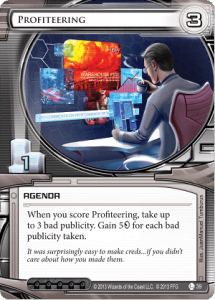
Score me first and I will solve your money problems for the rest of the game.
The obvious question is what to install; most of the time, you won’t have to think. Just install whatever you have in hand. Whenever possible you should install 3 cards simultaneously so that the Runner can’t check all of them safely. If the Runner seems to be checking every card you install, skew your installs towards traps; if the Runner focuses on centrals, you can get greedy and install 2-3 agendas.
You should install things only if you get value from the install; always install Psychic Field, since it’s useless otherwise. Installing Fetals, Shocks and Snares serves only to hide Agendas, so keeping them in HQ is usually better. Of course, you should always tailor your strategy to what the Runner seems to be going for.
You’ll have two kinds of turns; install turns and off turns. An install turn means installing 3 cards while staring the Runner square in the eye (if they have less than five cards in hand, even better). An off turn means playing a mix of economy operations, Cerebral Casts and drawing cards. There’s no point in installing cards if you have less than 3 credits; ideally your credit count stays above 10 at all times. The instant you go broke is the instant your unrezzed cards have no power.
Cerebral Cast is a key card, and games often come down to it; landing a Cerebral Cast means either winning the game through Scorch, or nailing the Runner with a crippling Brain Damage. You should try to play Cerebral Cast click 1, representing double-Scorch; even if you don’t have it, most Runners won’t dare to call your bluff.
As hard as all this might seem, this deck wins more games than you might think; Runners faceplant a Snare on click 3, and you kill them with some mix of Grey and Black Ops.
Beating the Deck
An Iceless deck naturally has a lot of predators, not least of which is the basic “Click: Make a Run” action. You have no way to prevent your agendas from being accessed repeatedly; a prescient (or lucky) Runner will beat you every time.
Criminals have the easiest time against this deck, a wide-open HQ means that Account Siphon can be played at their convenience. You can punish any tag-floaters with Scorched Earth; assuming, of course, that they forget to install their Plascrete Carapace. Plascrete into multiple Siphons makes your life very difficult.
Gabe gets infinite money against us, but the true nightmare is Silhouette; a free expose effect every turn will sink most of your attempts at sneaky traps and agenda scores. You’ll have to lean heavily on your Psychic Fields to combat it and keep HQ very prickly.
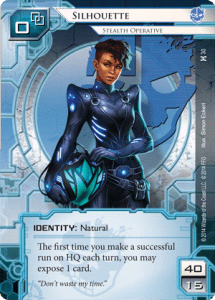
On the plus side, it’s not like Blackguard will ever hurt us.
Efficient card draw means the Runner can recover faster than we can hurt them; Wyldside, Diesel and Quality Time are always sad to see. Hand size increase gives them a buffer against the flatline, and tag avoidance (Decoy, New Angeles City Hall) gives them breathing room against Cerebral Cast and Snare. Obviously, Net Damage prevention (Net Shield, Deus X, Feedback Filter) is bad for you.
Cards that let you sift through R&D without accessing it (Keyhole, Indexing) are bad news. Multi-access cards (Medium, Nerve Agent, Interfaces) are as dangerous for you as they are for them; there’s nothing stopping the Runner from accessing 10+ cards with a Medium, but a simple Snare + Fetal combo will put an end to that very quickly.
But really, the best way to beat this deck is play it safe. Scoring 7 points via endless 3/1s would require the Corp to get 21 credits and use 28 actions as well as 7 cards; this requires 10+ turns of uninterrupted scoring. You have plenty of time, so play around everything that could kill you, no matter how remote the possibility. Always draw up to 5, run on your first click and don’t get greedy.
Card-by-Card Analysis
Agendas
-False Lead is truly excellent in this deck. Scoring one puts the runner in a vice grip, making any second-click runs potentially fatal.
-Fetal AI is not something you ever plan on scoring, but dealing 2 Net Damage on access for free is fantastic. Even if you can’t pay to activate Snare, you can always count on Fetal AI. Especially fantastic if they hit it, then opt not to steal it because they fear the 3rd Net Damage.
-Profiteering, if scored, essentially sets you for life. There’s no reason to take anything less than 3 Bad Pub with it, and 15 credits will carry you for most of the game.
-House of Knives punishes careless Runners. An active House of Knives means they can’t run with less than 4 cards in hand due to the threat of Snare. Against a careful runner, this will buy you a turn as they redraw to match every ping. Note that you have no opportunity to use it after they access, so you cannot use it to kill them after they hit a Snare. Use it before showing them the card.
-Philotic Entanglement is a swingy card; too often it’ll just be plucked from R&D, but sometimes it’s the only card that can get you a win. Note that it counts Shi.Kyus as agendas, so you can get some outrageous 5+ Net Damage plays with it.
-Gila Hands Arcology rounds out the agenda suite, and while it’s unspectacular it will still do work for you when scored. You’ll sometimes have to click for credits to keep your head above water, and a scored Gila Hands will help out in longer games.
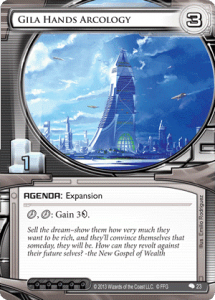
What are you gonna do, run Unorthodox Predictions?
Assets
-Jackson Howard is not as vital here as it is in most Corp decks, but it is still a solid role-player; it masquerades as an agenda/trap when installed, it fills your hand back up if you go install-draw-draw and lets you recycle dead Snares.
-Psychic Field is very strong in this deck, creating a dichotomy in the Runner’s mind: keep less cards in hand and Psychic Fields hurt less, but Snares + EMPs may kill. If the runner guesses wrong, Psychic Field sets them back five cards, granting you your version of a “Scoring Window”.
-Shock is a workhorse, making R&D prickly (for free!) and protecting Archives. In some cases, you can set-up a kill by stuffing Archives full of Shocks, Shi.Kyus and 1-pointers; the Runner has no choice but to access all cards in Archives, and must steal any Agendas accessed unless they have additional costs.
-Snare! is the poster child for this deck; it damages and it tags. Careless runners will float the tag or access it on their final click; this usually results in a win for you. Keeping four credits for it is the hardest thing you’ll have to do. Note that you don’t have to activate it, but you will almost always want to.
-Shi.Kyu is almost as money-hungry as Snare, but you want its effects; put 3-4 credits into it and you’ll get either a Flatline, a Scoring Window or a 1-agenda point buffer. Install it only if the Runner never runs HQ, otherwise keep it in hand.
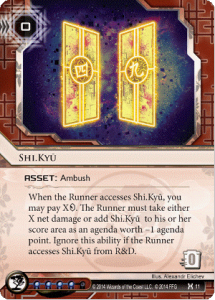
Remember: this triggers in Archives, but not in R&D.
Operations
-Cerebral Cast gives a choice to the Runner: “Bad or Worse”. As I said earlier, you should always represent double Scorch with it; if the Runner knows a tag won’t kill them, they’ll take the tag and you’ll have wasted your time.
-Hedge Fund is a good card.
-Medical Research Fundraiser is also a good card, sometimes even better than Hedge Fund. We tax the Runner via damage, not credits, so while the drawback is meaningful, being able to go from 3 to 8 in a single click is worth it.
-Neural EMPs accumulate in HQ and will never be played unless you win the game on the spot. Threatening Neural EMP kills is another reason why you always want a good-sized stack of credits.
-Scorched Earth gets you roughly 50% of your wins. Some Runners don’t expect it out of Jinteki. Some don’t have Plascrete in their deck. Some faceplant Snare on their last click. Some will try to call your bluff after a Cerebral Cast. In all these cases, play Scorched Earth and be happy.
-Subliminal Messaging is a recent addition to the deck, and possibly a contentious one. The truth is that this deck lives and dies by its economy; its ability to get from 0 to 10 credits as quickly as possible, recovering from a disaster Account Siphon or two. Subliminal Messaging basically turns a card draw into a free credit, and you’ll sometimes get to recur them as the Runner recovers from a Psychic Field. It also lets you punish Criminals that Account Siphon you down to 0; you can Subliminal Messaging, credit, credit, Scorch (once) for the win.
Future Cards
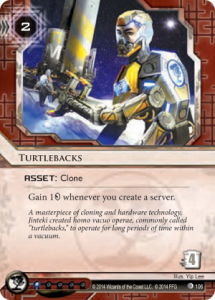
Turtlebacks might be an interesting economy option, leveraging your triple-install turns for a free credit as well as demanding a run & trash from the Runner. It might spawn a more credit-taxing version of Tropical Jinteki.
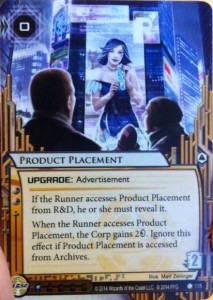
Product Placement is a ways-off, in the last pack of the SanSan Cycle, but it’s a spicy one. I’m currently running it in place of Jacksons. Free economy should not be undervalued, and this does a lot of work for you.
Roads not Taken
Choosing which cards to cut from a deck is as important as choosing which cards to put in. For this final section I’ll provide some insights as to which cards didn’t make the cut:
-The Always-Advance package: Mushin No Shin, Ronin, Project Junebug, Cerebral Overwriter, Trick of Light; simply put, this is a different deck. The first iteration included them, and they never performed. R&D is always wide open, so Junebugs and Overwriters have very little chance of making it to your hand, as do Ronins. If you IAA a card every turn, that’s only one thing the runner has to check, and anything other than an Overwriter can be checked safely. Failed traps will cost you a lot of money as the Runner pounds your centrals. Overwriters also mean cutting into your Scorch count.
I wouldn’t begrudge you for trying to make it work, but in my experience a never-advance strategy is stronger. You never waste money advancing Junebugs, R&D is less trashable and you don’t rely on coinflip “bluffs” to win.
-Clone Retirement: It was in the deck for a while instead of Gila Hands, but it just doesn’t do enough when scored. Yes, scoring it out of hand is nice, but it does nothing to advance your real plan, which is a flatline kill. You won’t win through points.
-NAPD Contract: Profiteering has anti-synergy with this on two levels, making it both easier to steal and impossible to score for you. It also weakens Philotic plays and lets the runner win with fewer agendas, which means less Net Damage.
-Melange Mining Corp: As an economy card that lets you go from 1 to 7 in a single turn, it certainly is a contender. Ultimately, it’s too easy to trash from R&D, and you’ll never get more than one use out of it, if that.
-All the ICE: The deck would probably be stronger if we ran at least some ICE to protect centrals; Yaguras, Pups and Himitsu-Bakos would go a long way to slow down the Runner. But this is Tropical Jinteki, and there is no ICE allowed here.
-Diversified Portfolio: You might think this is a perfect deck for going horizontal, but it really isn’t. Diversified does nothing when you’re at your weakest, and if you spend your turn installing Shocks and Snares to make Diversified better, those are clicks you could’ve spent clicking for credits. You don’t want to leave agendas lying around; you want to score them ASAP to further the flatline plan. Diversified simply requires too many stars to align before it becomes good, and we need our economy to come online on turn 1.
-Restructure has a similar problem: it does nothing on its own. While going from 10 to 15 is definitely good, the deck struggles most in hitting that 10 credit mark.
-Anonymous Tip: It’s faster than Jackson, and you can’t trash it out of R&D. I certainly wouldn’t fault you for swapping out Jacksons for Tips, and you may find success with it. Jackson is more versatile, while Tip is very narrow and powerful in what it does.
Why you should try this deck
This is about as far as you can get from “standard” Netrunner without changing the rules. Playing this deck sets the tone of the engagement, and your opponent must match it or lose. If you’re sick of Noiseshop installing viruses for 10 turns straight, play this and watch as 90% of your opponent’s cards become blank. I don’t care about your fancy Stealth breakers or Parasite recursion; instead, I am going to work-compress you until someone dies.
I think this is a good place to stop for now; next week we’ll be discussing a different deck. Feedback is, of course, highly appreciated. If you have any suggestions for deck archetypes you’d like to see me discuss, email me at Nagnazul@gmail.com.
Until next time, keep on running, and keep on accessing Snares.





